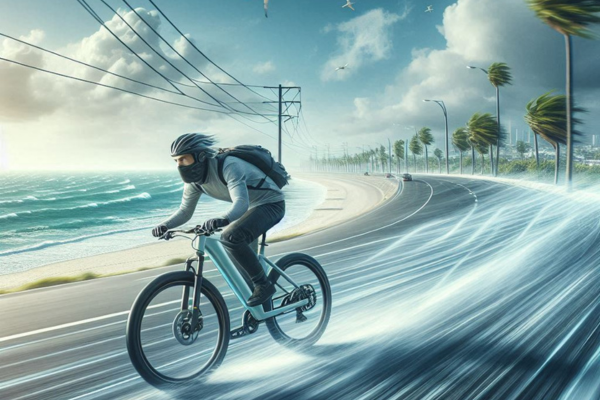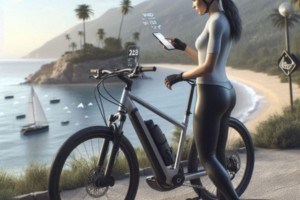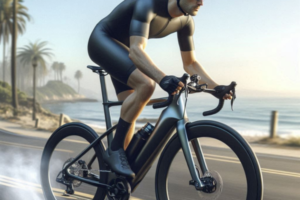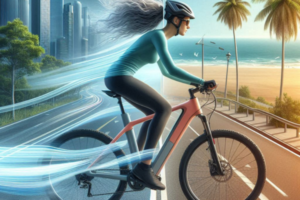🌬️ Understanding Crosswinds: How They Influence Your E-Bike Experience
Crosswinds are one of the most underestimated challenges faced by electric bicycle riders. While many cyclists focus on hills, road surfaces, or headwinds, side winds—or crosswinds—can significantly impact stability, control, speed, and even rider confidence. Unlike headwinds that slow you down in a straight line, crosswinds affect your entire body and your bike’s balance by pushing laterally, often catching you by surprise. That sideways force can lead to dangerous wobbles, overcorrections, and an exhausting ride if you’re unprepared.
E-bike riders, in particular, are more affected than traditional cyclists. Why? Because e-bikes typically have larger frames, wider surfaces, additional accessories like battery packs and racks, and greater overall weight. These features make them slightly more wind-resistant, but also more affected by strong lateral forces—especially when riding at speed.
🔬 What Exactly Are Crosswinds?
A crosswind is defined as wind that blows across your path of travel rather than against or behind you. It can come from either side—left or right—and its strength and consistency may vary based on local geography, weather fronts, or road design. Unlike a steady headwind, crosswinds can be sudden and unpredictable, especially when passing gaps between buildings, trees, or open valleys.
- True crosswind: Blows directly perpendicular to your direction of travel.
- Quartering wind: Hits your front or rear side at an angle—less forceful but still destabilizing.
- Gust: A sudden burst of wind, usually more dangerous than steady crosswinds due to the lack of warning.
⚠️ Common Problems Caused by Crosswinds
When riding through crosswinds, riders may face several technical and physical challenges, including:
- Balance disruption: The lateral force may cause your bike to veer off its intended line, requiring constant steering corrections.
- Rider fatigue: Continuously battling the wind leads to faster exhaustion, especially in the arms, shoulders, and core.
- Speed reduction: While crosswinds don’t reduce speed as directly as headwinds, they force riders to reduce velocity for safety.
- Increased danger in traffic: A sudden gust may push you toward other lanes or into dangerous positions if riding near cars.
🧠 Why E-Bikes React Differently Than Regular Bikes
Electric bicycles often have heavier frames, larger frontal areas, and more accessories such as fenders, racks, panniers, and motor units. These components create more surface for wind to push against. Additionally, higher speeds reached thanks to pedal-assist can increase the intensity of crosswind impact. An e-bike traveling at 25 km/h into a 30 km/h crosswind will face a different aerodynamic challenge than a traditional bike moving at 15 km/h.
| Factor | Traditional Bike | Electric Bike |
|---|---|---|
| Weight Distribution | Evenly distributed | Rear-heavy (motor & battery) |
| Frontal Surface Area | Narrow frame, fewer components | Broader frame, added accessories |
| Reaction to Gusts | Less vulnerable | More affected, especially at speed |
🌍 Environmental Factors That Worsen Crosswinds
Certain locations are more prone to hazardous crosswinds due to topography and manmade structures. Coastal roads, open fields, and bridges are known wind corridors. Riders near tall buildings may also experience wind tunnels, where gusts are funneled between structures, causing abrupt side pushes. Elevation changes also amplify wind speeds; riding on elevated bike lanes or overpasses increases exposure.
The more you understand about crosswind behavior and your bike’s response to it, the more confident and capable you’ll feel when riding under challenging wind conditions. In the next blocks, we’ll explore riding posture, equipment, and mindset strategies to make sure you stay in full control no matter how the wind blows.
💡 Takeaway: Crosswinds aren’t something to fear—they’re a challenge to master. Knowing how they work is your first step to turning them from threat to triumph.
🚴♀️ Mastering Body Position and Technique in Crosswinds
When riding into crosswinds, staying upright isn’t just about balance—it’s about biomechanics, posture, and understanding how your body interacts with your bike and the environment. Riders often believe that speed or power is enough to overpower wind, but in reality, maintaining control requires subtle, deliberate body positioning and consistent posture adjustments. A few degrees of forward lean, a relaxed elbow, or even the way you hold your handlebars can make the difference between swaying with the wind or struggling against it.
🧘♀️ Body Positioning for Balance and Control
The key to stability in crosswinds is lowering your center of gravity and minimizing wind resistance. When wind pushes from the side, your body acts as a sail. Adopting a compact, centered riding position not only reduces surface area but also improves reaction time when sudden gusts occur.
- Lean slightly forward: Bring your torso closer to the handlebars to lower your center of gravity. This reduces upper-body sway and helps maintain traction on the front wheel.
- Keep knees slightly bent: Bending your knees allows better absorption of sudden shifts and maintains balance through dynamic movement.
- Relax your shoulders and elbows: Tension transfers instability to the handlebars. Keep your arms flexible to act as shock absorbers.
- Keep your head forward and eyes up: Looking ahead allows you to anticipate changes in road texture, obstacles, or incoming gusts.
🔄 Counter-Steering for Wind Compensation
When strong crosswinds strike, especially from the side, your e-bike may naturally begin to drift. Instead of fighting it directly, apply gentle counter-steering—subtle pressure toward the wind’s origin. This creates a balanced tension that keeps your trajectory straight without overcorrection.
- Apply gentle handlebar input: Avoid jerky or sudden moves; keep corrections fluid and gradual.
- Engage core muscles: Stabilize your torso to help steer with control from your center, not just your arms.
- Let the bike float slightly: Accept small shifts without resisting every micro-movement. Trust your momentum.
🛣️ Road Position and Lane Awareness
Riding in crosswinds also means rethinking your lane position. When wind comes from the left, hug the right side of the lane (if safe). When it comes from the right, ride slightly more centered to avoid being pushed into curbs or traffic. Awareness of space around you is just as important as steering skill.
| Wind Direction | Recommended Position | Why It Works |
|---|---|---|
| Left-side crosswind | Move slightly right in your lane | Gives buffer if wind pushes you left |
| Right-side crosswind | Stay more centered | Avoids drifting toward curbs |
| Gusty or shifting winds | Keep a wide buffer from traffic | Allows space for unexpected pushes |
🧠 Mind Over Momentum
Fear is a natural response to crosswinds, especially for newer riders. But fear tightens muscles, reduces responsiveness, and leads to overcorrection. The best defense against wind isn’t resistance—it’s adaptation. Breathing techniques, relaxation, and positive focus help your body remain fluid and reactive.
- Inhale deeply through the nose, exhale slowly: This regulates your nervous system and maintains calm.
- Visualize staying straight: Your bike tends to follow where you look and how you visualize control.
- Practice in moderate winds: Building skill gradually improves confidence in harsher conditions.
💡 Pro Tip: Don’t fight the wind. Adapt your shape, trust your instincts, and let your posture do the work.
⚙️ E-Bike Design and Components That Help You Ride Smarter in Crosswinds
Handling crosswinds isn’t just about how you ride—it’s also about what you ride. Your e-bike’s frame geometry, tire choice, battery placement, and accessories all contribute to how well you stay in control when the wind picks up. While rider posture is essential, an optimized bike setup can significantly reduce wind resistance and improve safety. Understanding which features increase your wind profile and which reduce drag is the first step to building a wind-smart e-bike.
🚲 Frame Shape and Geometry
E-bikes come in various shapes, from compact step-through models to aggressive sport frames. When riding in windy conditions, certain designs offer better control than others. Compact or trapezoidal frames typically have fewer vertical surfaces and lower center-of-gravity, making them more stable when hit by side winds.
- Step-through frames: Reduce vertical surface area and help distribute weight evenly.
- Lower top tubes: Allow quicker foot-down response in emergencies.
- Integrated battery frames: Reduce turbulence by keeping battery weight within the core of the frame rather than externally mounted.
🛞 Tire Size, Width, and Pressure
Tires play a surprising role in wind stability. Narrow tires offer less rolling resistance, but they also reduce surface grip, making bikes feel twitchier during gusts. Wider tires with a lower PSI improve ground contact and make it easier to stay planted when wind direction shifts unexpectedly.
| Tire Type | Effect in Crosswinds | Best Use Case |
|---|---|---|
| Skinny (28mm or less) | Less drag but unstable in gusts | Dry, calm conditions |
| Medium-width (32–40mm) | Good balance of speed and grip | Mixed environments |
| Wider (42mm+) | Greater traction, better shock absorption | Coastal, windy, or rough roads |
🔋 Battery and Motor Placement
Where your battery and motor are located affects how your e-bike responds to wind. A low-mounted battery (on or integrated into the downtube) improves stability, while rear-rack-mounted batteries shift weight upward and to the back—reducing traction on the front wheel and making crosswinds more pronounced.
- Mid-drive motors: Centralize weight and improve balance during side winds.
- Hub-drive motors: Heavier in the wheel, sometimes creating momentum drag if not counteracted with proper riding posture.
- Downtube batteries: Keep weight low and wind resistance minimal.
👜 Aerodynamic Accessories
Large panniers, wide fenders, upright mirrors, or high baskets may look functional—but in windy environments, they can turn your bike into a sail. The more surface area you present to the wind, the more instability you’ll feel.
- Choose frame-hugging panniers: Keep storage streamlined and below saddle height.
- Opt for low-profile fenders: These reduce drag without compromising protection.
- Avoid front baskets in wind-prone regions: They increase turbulence and reduce front-end control.
🧠 Bonus Tip: Simplicity Improves Control
In windy environments, minimalism is an advantage. Stripping down your bike to essentials on high-wind days helps reduce unnecessary drag. The fewer exposed components, the better your ride will respond.
💡 Insight: Your gear is either working with the wind—or against you. Choose every component like you’re designing for flight.
✅ Pre-Ride Checklist and Safety Prep for Windy Conditions
Preparing to ride in windy conditions isn’t about fear—it’s about confidence. With a clear checklist and thoughtful preparation, you can enjoy safe, controlled, and even empowering e-bike rides on breezy days. Whether you’re a seasoned coastal commuter or heading out on a weekend trail, knowing how to anticipate crosswinds before they hit is one of the best ways to prevent instability and fatigue.
🌤️ Step 1: Check the Wind Forecast
Before any ride, take two minutes to check wind data using apps like Windy, AccuWeather, or your favorite weather widget. Focus on wind speed, direction, and gust intensity—not just general conditions.
- 0–15 km/h (0–9 mph): Minimal impact. Ride as usual.
- 15–30 km/h (9–18 mph): Moderate crosswind; adjust gear and posture.
- 30–45 km/h (18–28 mph): Strong gusts likely. Consider alternate routes.
- 45+ km/h (28+ mph): High-risk for e-bike riders. Delay or limit exposure to open areas.
🛠️ Step 2: Make Equipment Adjustments
Once you confirm wind will be part of your ride, inspect your e-bike with a specific checklist in mind. Focus on traction, control, and minimizing drag.
| Component | What to Check | Why It Matters |
|---|---|---|
| Tire Pressure | Reduce by 5–10 PSI | Increases surface grip and stability |
| Handlebar Tightness | Firm and centered | Essential for precise control in gusts |
| Accessories | Remove bulky panniers or baskets | Reduces drag and wobble |
| Lights and Mirrors | Secure and low profile | Avoid sudden shakes or loosening |
👕 Step 3: Dress for Aerodynamic Success
Your clothing plays a direct role in how much wind resistance you create. Choose close-fitting, wind-resistant layers and avoid anything loose that can flap or pull.
- Wear fitted sleeves and jackets: The less fabric movement, the better your balance.
- Choose zippered pockets: Prevent items from shifting and throwing off your posture.
- Wear gloves with grip: Helps maintain handlebar control if you’re pushed by wind.
🧭 Step 4: Plan Wind-Smart Routes
Riding into headwinds on the outbound leg and returning with a tailwind is a classic cycling strategy. But with crosswinds, you also need to avoid long stretches of exposed terrain.
- Ride behind buildings, trees, or fences: These natural barriers reduce wind pressure.
- Stay off bridges or ridges when gusts exceed 30 km/h: Elevated exposure multiplies wind force.
- Avoid routes with oncoming heavy traffic: Sudden wind shifts plus close vehicles increase risk.
🧠 Final Step: Mental Preparation
Even with all the right gear and prep, your mindset is your best defense. Accept that some wobble or instability will occur—and know how to breathe through it. A confident rider reacts wisely, not nervously.
💡 Tip: Prepare like a pro and ride like the wind is your training partner—not your opponent.
💬 Frequently Asked Questions (FAQs)
1. Are crosswinds dangerous for e-bike riders?
Crosswinds are not inherently dangerous if you’re prepared, but they can pose risks when unexpected. The sudden lateral force can shift your line of travel or cause balance issues, especially at high speeds or in traffic. However, with proper riding posture, awareness, and setup, crosswinds can be managed confidently and safely.
2. Can the type of e-bike I ride affect crosswind performance?
Absolutely. Bikes with compact frames, low-mounted batteries, and mid-drive motors handle crosswinds better due to centralized weight and reduced frontal exposure. Lightweight, streamlined designs offer less resistance to wind. Conversely, bikes with wide frames, rear-mounted batteries, and bulky accessories are more affected by strong lateral forces.
3. Should I stop riding if winds get too strong?
Yes, if wind speeds consistently exceed 45 km/h (28 mph), especially with gusts over 60 km/h (37 mph). Under these conditions, even experienced riders may struggle with control. Delay your ride or switch to a more sheltered route. Safety should always come before schedule.
4. How should I breathe and respond when hit by a sudden gust?
Keep your arms relaxed, grip the handlebars evenly, and steer gently into the wind (counter-steering). Avoid tensing up. Take a slow breath, stabilize your core, and regain your rhythm. Crosswinds are momentary—your calm reaction is key to riding through them.
5. What’s the best way to train for windy conditions?
Start in light wind (10–20 km/h) and practice riding near protective barriers like fences or low traffic streets. Focus on body positioning, gear choice, and visualizing straight-line control. Gradually build experience in stronger winds as your technique improves.
💖 Final Thoughts: Ride With the Wind, Not Against It
Crosswinds teach us something beyond cycling mechanics—they reveal our ability to stay centered in changing environments. They remind us that not every force in life can be faced head-on. Some must be ridden through with grace, strategy, and trust in our own movement.
On your e-bike, every gust is an invitation to adjust—not panic. With each kilometer, your confidence builds. Your posture refines. Your reaction time sharpens. You learn to listen to the invisible push of air and respond like the road warrior you are.
So the next time the forecast calls for wind, don’t cancel the ride. Prepare. Adapt. And flow forward knowing that true control doesn’t come from force—it comes from understanding.
💡 Inspiration: The strongest riders aren’t those who fight the wind—they’re the ones who learn to ride with it.
🌍 Join the Conversation: What’s Your Wind Strategy?
How do you prepare for wind? What posture tricks, equipment upgrades, or route changes have helped you ride through strong gusts with confidence? Your experience could inspire and guide someone else who’s just beginning to face their first coastal challenge or open-road breeze.
Share in the comments:
🌬️ What’s the most powerful wind you’ve ever ridden through?
🔧 Have you modified your bike setup specifically for windy rides?
🚴♀️ What’s one piece of advice you wish someone had told you earlier?
Together, we’re not just building strength against the wind—we’re building a smarter, safer community of e-bike riders that ride with intention and joy. ✨



